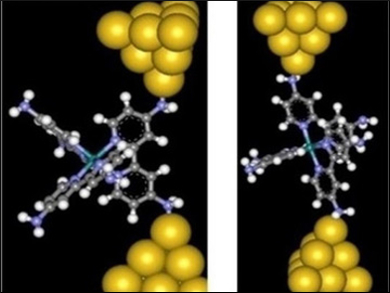In molecular electronics, single molecules act as active components in electronic circuits. Single‐molecule junctions are a key component of molecular electronics. In single‐molecule junctions a single molecule bridges metal electrodes. To realize molecular electronic devices, it is important that functional single‐molecule junctions are connected to each other by using conductive wires and joint units on the atomic scale. Such a joint unit is necessary to have multiple joint configurations on demand. Although single‐molecule junctions with multiple joint configurations and their conductance behavior has been reported, there are a few studies on joint units that control and change the direction of the charge transport through the junctions.
Osamu Ishitani, Manabu Kiguchi, Shintaro Fujii, Tokyo Institute of Technology, Japan, and colleagues have shown that a ruthenium tris-bipyridine (RuBpy) complex can be a joint unit that controls charge transport directions. By introducing NH2 anchoring groups to the bipyridine units, the Ru complex has six anchoring positions.
The team has investigated the electron transport properties of the single‐molecule junction of RuBpy with the scanning tunneling microscope (STM) break junction (BJ) technique. The measurements showed that high and low conductance states exist. Correlation Analysis showed that the RuBpy single‐molecule junction works as a multi‐joint unit with multiple binding positions. In the high state, the molecule binds to Au electrodes via NH2 groups on the same bipyridine unit. In the low state, it binds via NH2 groups of different bipyridine units (pictured). The RuBpy molecule can interconnect two Au electrodes linearly and vertically in the high and low conductance states, respectively.
The team used conductance measurements, correlation analysis, and comparative experiments with only the Bpy ligand to characterize the RuBPy’s properties for molecular electronics. It was found that the Ru complex has multiple charge transport paths, where the charge is carried through the complex either vertically or horizontally.
- Ruthenium Tris-bipyridine Single-Molecule Junctions with Multiple Joint Configurations,
Yuuki Komoto, Yasuomi Yamazaki, Yusuke Tamaki, Madoka Iwane, Tomoaki Nishino, Osamu Ishitani, Manabu Kiguchi, Shintaro Fujii,
Chem. Asian J. 2018.
https://doi.org/10.1002/asia.201800166




